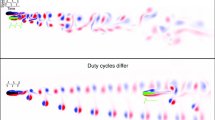Abstract
Tadpole swimming, including a solitary tadpole swimming and schooling side-by-side in an in-phase mode, is investigated numerically in the present paper. The three-dimensional Navier-Stokes equations for the unsteady incompressible viscous flow are solved. A dynamic mesh fitting the tadpole’s deforming body surface is adopted. The results showed that for a solitary tadpole swimming, two vortex rings are shed in each undulating period. However, as the resultant force on the tadpole is drag, the vortex rings are obviously asymmetric, shaped like “C”. When the resultant force in the swimming direction approaches zero, the axes of the vortex rings are nearly vertical to the swimming direction. Distorted vortex rings are found when the resultant force on the tadpole is thrust. When the tadpole model obtains the optimum propulsive efficiency, its swimming speed and undulating frequency are close to the values observed in nature. For tadpoles swimming side-by-side in an in-phase mode, the vortex structures in the wake may merge, split and recombine. Compared with a solitary tadpole swimming, only a small hydrodynamic advantage occur with schooling in parallel, which may be one of the reasons why tadpoles rarely, if ever swim, side by side for any amount of time or distance in nature. The effect of the undulating frequency on the tadpoles schooling is similar to that on a solitary tadpole. In addition, with an increase in the Reynolds number, the thrust force and the propulsive efficiency both increase, while the power consumption decreases. We also found that the tadpole benefits from the vortex pair shedding from its blunt snout, which can strengthen the vortex intensity in the wake and improve the pressure distribution.
Similar content being viewed by others
References
Videler J J. Fish swimming [M]. Springer Science & Business Media, 2012.
Wassersug R J, Hoff K. The kinematics of swimming in anuran larvae [J]. Journal of Experimental Biology, 1985, 119(1): 1–30.
Azizi E, Landberg T, Wassersug R J. Vertebral function during tadpole locomotion [J]. Zoology, 2007, 110(4): 290–297.
Olson R S, Hintze A, Dyer F C, et al. Predator confusion is sufficient to evolve swarming behaviour [J]. Journal of the Royal Society Interface, 2013, 10(85):20130305.
Humston R, Ault J S, Lutcavage M and Olson D B. Schooling and migration of large pelagic fishes relative to environmental cues [J]. Fisheries Oceanography, 2010, 9(2):136–146.
Sung G P, Sung H J. Hydrodynamics of flexible fins propelled in tandem, diagonal, triangular and diamond configurations [J]. Journal of Fluid Mechanics, 2018, 840:154–189.
Lin X, He G, He X, Wang Q, Chen L. Numerical study of the hydrodynamic performance of two wiggling hydrofoils in diagonal arrangement [J]. Journal of Applied Mathematics & Physics, 2017, 05(1):31–38.
Maertens A P, Gao A, Triantafyllou M S. Optimal undulatory swimming for a single fish-like body and for a pair of interacting swimmers [J]. Journal of Fluid Mechanics, 2017, 813:301–345.
Mohsen Daghooghi, Iman Borazjani. The hydrodynamic advantages of synchronized swimming in a rectangular pattern [J]. Bioinspiration & Biomimetics, 2015, 10(5):056018.
Deng J, Shao X M, Yu Z S. Hydrodynamic studies on twotravelling wavy foils in tandem arrangement [J]. Physics of Fluids, 2007, 19(11):305–371.
Dong G J, Lu X Y. Characteristics of flow over travelling wavy foils in a side-by-side arrangement [J]. Physics of Fluids, 2007, 19(5):057107.
Wang L, Wang M, Fu Q, Miao R D. Numerical simulation of two self-propelled fish swimming in a side-by-side arrangement[J].Chinese Journal of Computational Mechanics, 2014,31(1):103–109.
Caldwell, J P. Structure and behaviour of Hyla geographica tadpole schools, with comments on classification of group behaviour in tadpoles [J]. Copeia, 1989, 4:938–950.
Heursel, A D, Celio Haddad F B. Schooling and swimming behaviors of Hyla semilineata tadpoles (anura,hylidae) [J]. Iheringia, Sér. Zool., Porto Alegre, 2002, 92(1):99–104.
Breden F, Lum A, Wassersug R J. Body size and orientation in aggregates of toad tadpoles Bufo woodhousei [J]. Copeia, 1982, 3:672–680.
Wassersug R J, Lum A M, Potel M J. An analysis of school structure for tadpoles (Anura: Amphibia) [J]. Behavioral Ecology and Sociobiology, 1981, 9:15–22.
Chen X Y, Hu W R. Numerical investigation of tadpole models swimming in side-by-side arrangement [J]. Journal of Hydrodynamics, Ser.A, 2017, 32(2):133–140.
Handrigan G R, Wassersug R J. The anuran Bauplan: A review of the adaptive, developmental, and genetic underpinnings of frog and tadpole morphology [J]. Biological Reviews, 2007, 82(1):1–25.
Köhler G, Lehr E, McCranie J R. The tadpole of the Central American toad Bufo luetkenii Boulenger [J]. Journal of Herpetology, 2000: 303–306.
Yuan H T, Hu W R. A numerical study on tadpole swimming in the wake of a D-section cylinder [J]. Journal of hydrodynamics, Ser. B, 2017, 29(6):1044–1053.
Hoff K, Wassersug R J. Tadpole locomotion: axial movement and tail functions in a largely vertebraeless vertebrate [J]. American Zoologist, 2000, 40(1):62–076.
Lu X Y, Yang J M, Yin X Z. Propulsive performance and vortex shedding of a foil in flapping flight [J]. Acta Mechanica, 2003, 165(3–4): 189–206.
Martinat G, Braza M, Hoarau Y, Harran G. Turbulence modelling of the flow past a pitching NACA0012 airfoil at 105 and 106 Reynolds numbers[J]. Journal of Fluids & Structures, 2008, 24(8):1294–1303.
Hu W R, Tong B, Ma H, Liu H. A computational study of a backward swimming hydrodynamics of the eel Anguilla [J]. Journal of Hydrodynamics, 2005, 4(4):438–447.
Cheng J Y, Zhuang L X, Tong B G. Analysis of swimming three-dimensional waving plates [J].Journal of Fluid Mechanics, 1991, 232(232): 341–355.
Author information
Authors and Affiliations
Corresponding author
Additional information
Project supported by the National Natural Science Foundation of China (Grant No.11472173).
Biography: Ting-ting Li(1993–), Female, Master
Rights and permissions
About this article
Cite this article
Li, Tt., Hu, Wr. & Chen, Xy. The three-dimensional hydrodynamics of tadpole model’s solitary swimming and parallel schooling. J Hydrodyn 32, 548–560 (2020). https://doi.org/10.1007/s42241-019-0071-8
Received:
Revised:
Accepted:
Published:
Issue Date:
DOI: https://doi.org/10.1007/s42241-019-0071-8



